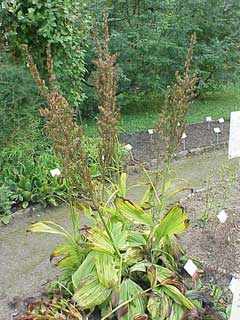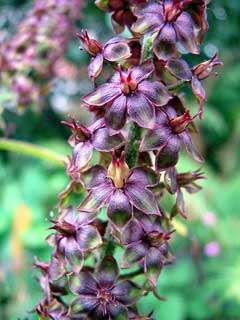 |
|
biolib.de |
 |
| commons.wikimedia.org/wiki/User:Nova |
Translate this page:
Summary
Physical Characteristics

 Veratrum nigrum is a PERENNIAL growing to 1.5 m (5ft) by 0.6 m (2ft in).
Veratrum nigrum is a PERENNIAL growing to 1.5 m (5ft) by 0.6 m (2ft in).
See above for USDA hardiness. It is hardy to UK zone 6. It is in flower from August to September. The species is hermaphrodite (has both male and female organs) and is pollinated by Bees, flies, Lepidoptera (Moths & Butterflies).
Suitable for: light (sandy), medium (loamy) and heavy (clay) soils. Suitable pH: mildly acid, neutral and basic (mildly alkaline) soils. It can grow in semi-shade (light woodland) or no shade. It prefers moist soil.
UK Hardiness Map
US Hardiness Map
Synonyms
Plant Habitats
Woodland Garden Sunny Edge; Cultivated Beds;
Edible Uses
References More on Edible Uses
Medicinal Uses
Plants For A Future can not take any responsibility for any adverse effects from the use of plants. Always seek advice from a professional before using a plant medicinally.
Analgesic Anthelmintic Emetic Errhine Expectorant Laxative Vermifuge
The root is anthelmintic, emetic, errhine, expectorant, laxative and vermifuge[178, 218]. This herb is highly toxic and should not be used internally, or even externally, without expert guidance[K]. The whole plant is analgesic[218].
References More on Medicinal Uses
The Bookshop: Edible Plant Books
Our Latest books on Perennial Plants For Food Forests and Permaculture Gardens in paperback or digital formats.

Edible Tropical Plants
Food Forest Plants for Hotter Conditions: 250+ Plants For Tropical Food Forests & Permaculture Gardens.
More

Edible Temperate Plants
Plants for Your Food Forest: 500 Plants for Temperate Food Forests & Permaculture Gardens.
More

More Books
PFAF have eight books available in paperback and digital formats. Browse the shop for more information.
Shop Now
Other Uses
Insecticide
The dried and powdered root is used as an insecticide and a parasiticide[172]. It is also effective against caterpillars and mammals so great caution is advised[1, 19, 20].
Special Uses
Scented Plants
References More on Other Uses
Cultivation details
Requires a deep fertile moisture retentive humus-rich soil[200]. Succeeds in full sun if the soil does not dry out but prefers a position in semi-shade[200]. Dislikes dry soils[42]. Grows best in a cool woodland garden or a north facing border[42]. Plants are hardy to about -25°c[187], especially if they are given a protective mulch in the winter. The flowers smell of rotten fruit and are visited by flies[187]. Members of this genus are rarely if ever troubled by browsing deer[233]. Plants are long-lived and can be left in the same position for years without attention[233].
References Carbon Farming Information and Carbon Sequestration Information
Temperature Converter
Type a value in the Celsius field to convert the value to Fahrenheit:
Fahrenheit:
The PFAF Bookshop
Plants For A Future have a number of books available in paperback and digital form. Book titles include Edible Plants, Edible Perennials, Edible Trees,Edible Shrubs, Woodland Gardening, and Temperate Food Forest Plants. Our new book is Food Forest Plants For Hotter Conditions (Tropical and Sub-Tropical).
Shop Now
Plant Propagation
Unless stored in damp sand at around 4°c the seed has a short viability[200]. Where possible it is best to sow the seed in a lightly shaded position in the greenhouse as soon as it is ripe[200]. Stored seed needs to be stratified but can be very slow to germinate. Germination can be erratic even for seed sown when it was fresh, it usually takes place within 3 - 12 months at 15°c but can be much longer[200]. The plant produces just one seedleaf in its first year, this forms an over-wintering bulb. It takes up to 10 years for the plant to reach maturity[200]. Sow the seed thinly so there is no need to thin or transplant them, and grow the seedlings on undisturbed in the pot for their first two years of growth. Apply a liquid feed at intervals through the growing season to ensure the plants do not become nutrient deficient. At the end of the second year plant out the dormant plants into individual pots and grow them on in light shade in the greenhouse for a further year or two before planting them out into their permanent positions in late spring or early summer. Division in March/April or in October. Establish the plants in pots in a shaded frame before planting them out[200]. Division is best carried out in the autumn because the plants come into growth very early in the spring[233]. Root cuttings, 6mm long with a bud, rooted in a sandy soil in a cold frame[200].
Other Names
If available other names are mentioned here
Native Range
TEMPERATE ASIA: Russian Federation (Altay, Buryatia, Chita, Gorno-Altay, Irkutsk, Kemerovskaja oblast, Krasnoyarsk, Novosibirsk, Tomsk, Tyva, Respublika), Kazakhstan, Mongolia, Russian Federation (Primorye), China (Heilongjiang Sheng, Henan Sheng, Hebei Sheng, Hubei Sheng, Gansu Sheng, Jilin Sheng, Guizhou Sheng, Liaoning Sheng, Shanxi Sheng, Shandong Sheng, Shaanxi Sheng, Sichuan Sheng, Nei Mongol Zizhiqu) EUROPE: Czechoslovakia, Austria, Switzerland, Hungary, Poland, Russian Federation (European part), Russian Federation (Saratov), Ukraine, Former Yugoslavia, Albania, Bulgaria, Italy, Romania, France
Weed Potential
Right plant wrong place. We are currently updating this section.
Please note that a plant may be invasive in one area but may not in your area so it's worth checking.
Conservation Status
IUCN Red List of Threatened Plants Status :

Growth: S = slow M = medium F = fast. Soil: L = light (sandy) M = medium H = heavy (clay). pH: A = acid N = neutral B = basic (alkaline). Shade: F = full shade S = semi-shade N = no shade. Moisture: D = dry M = Moist We = wet Wa = water.
Now available:
Food Forest Plants for Mediterranean Conditions
350+ Perennial Plants For Mediterranean and Drier Food Forests and Permaculture Gardens.
[Paperback and eBook]
This is the third in Plants For A Future's series of plant guides for food forests tailored to
specific climate zones. Following volumes on temperate and tropical ecosystems, this book focuses
on species suited to Mediterranean conditions—regions with hot, dry summers and cool, wet winters,
often facing the added challenge of climate change.
Read More
Expert comment
Author
L.
Botanical References
74200266
Links / References
For a list of references used on this page please go here
Readers comment
| Add a comment |
|
If you have important information about this plant that may help other users please add a comment or link below. Only comments or links that are felt to be directly relevant to a plant will be included. If you think a comment/link or information contained on this page is inaccurate or misleading we would welcome your feedback at [email protected]. If you have questions about a plant please use the Forum on this website as we do not have the resources to answer questions ourselves.
* Please note: the comments by website users are not necessarily those held by PFAF and may give misleading or inaccurate information.
To leave a comment please Register or login here All comments need to be approved so will not appear immediately.
|
Subject : Veratrum nigrum
|
|
|
|